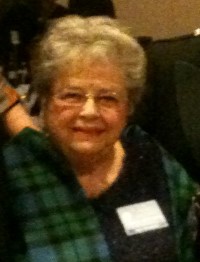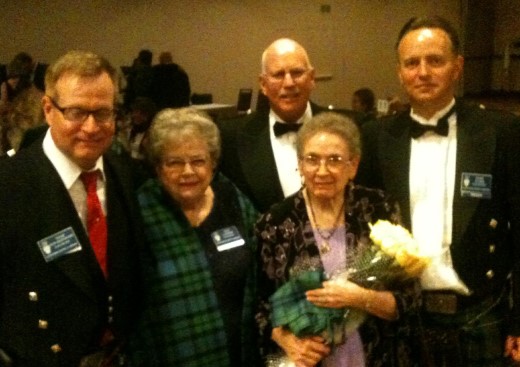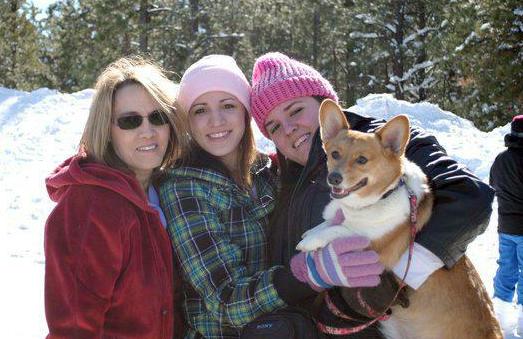The Curse of Scotland
For centuries, the Scots have associated certain horrific episodes and hated individuals with the most unusual artifact: a play card, the nine of diamonds. It's called the Curse of Scotland. Legends and anecdotes provide various explanations for the origin of the expression and its link to the playing card. Prominent among them is one that features William, Duke of Cumberland, third son of George II. Cumberland was the commander of the English troops that defeated the Jacobite army at the battle of Culloden in 1746.
According to one account, before the fighting began, officers sought Cumberland's orders. No parchment being handy for writing, the commander reached for a pack of playing cards lying nearby and randomly chose one. On its back, he scribbled "No quarter." The card was the nine of diamonds. For his success at Culloden, a flower was named after Cumberland. In England, it was known as Sweet William and in Scotland, Stinking Billy. |
|
Meet Our Members
Starting with the new year we will be publishing brief bios of some of our members. Some will be of new members, some long-time members and some our Board Members.
Jean Latimer - Board Member
Jean lives in Phoenix. She is a member of Clan MacKay. She retired from Mountain Bell, US West in 1985 as a Network Manager. She joined the Society around 1996 during Harold Stewart's first term as President and she also served as President some years later.

She became aware of the Society through Jean Whyman who was a friend from church. Jean Whyman had an assignment for the Society and she helped her out. Then she began attending the monthly meetings and eventually joined the Society. She became involved rather quickly, helping provide refreshments for the meetings held in Scottsdale at that time. She was asked to be Recording Secretary in Michelle Campbell's term as President and held that position for several years. She was also co-chair of the Robert Burns Dinner that year. She worked at the Games every year in many capacities after joining. "I enjoyed that time of seeing many friends, and meeting the public. We went through many changes such as moving the Games from Mesa to Phoenix and testing more than one location, before we found Steele Indian School Park," she remembers.
"I have always been very aware of my Scottish roots, since my maternal grandmother came from the Isle of Lewis. There were many Scottish family friends in my early childhood and I was named for one of them—Jean Stewart. I attended the Robert Burns Night event with my grandparents most every year from age 3 through 6. We would also drive four plus hours into Edmonton, Alberta to attend the Highland Games during the summer. I loved the bands, and I still do. I get my Clan MacKay affiliation from my grandmother, Isabelle MacKay Davison. All of these things brought me to the Caledonian Society and I still enjoy the association today."
"During the time that I served as President of the Society, we suffered greatly with a decline in attendance and we made the decision to move from Scottsdale into the Irish Cultural Center in Phoenix. It was a huge "cost cutter" for us but has also proved to be a wonderful location and relationship. We also were blessed to have Jason Temple show up and ask if he could help us with the Games by filling the available Games Chairman position. This has been a great advance and advantage for us, as he has taken us into remarkable growth and added venues. This will be our 50th anniversary of the Games and we look forward to an outstanding Games this March, 2014.
"I am so grateful to all the wonderful people I have had the honor to serve with as officers of the Society. They are quite simply THE BEST."
Jean Whyman - Long Term Member

Jean has lived in Phoenix for many years but is now moving to Texas to be near a daughter who lives there.
Another of her daughters, Pam Stewart, got her interested in the Caledonian Society when Pam's husband, Harold, was President of the Society. Jean joined the Society in 1998. She is a member of Clan Keith.
"I was born in the mountain of central Idaho in the small town of Grangeville and lived there through the depression years. When I was about 12 or 13 my family moved to Tacoma, Washington so my Dad could work in the shipyards at the beginning of WWII. There I attended high school and met my husband Charles Whyman who was in the Navy. After his discharge we drove and "old" car to Nebraska and then on to Gainesville, Texas where we were married in June 1946. We lived for 10 years in Lincoln, Nebraska and Kelly (as he was known by all) went to work for the Post Office as a letter carrier. In 1956 we moved to Phoenix with our one son and four daughters to get away from the snow, ice and cold. Our fifth daughter was born in Arizona.
"When all of the children were in school, I worked at Good Samaritan Hospital in the Diet Office. I had intended it to last for a few short years but it extended on for 22 years. I finally retired in 1992."
Jean has been a faithful attending member since she first joined. She has worked nearly every year at the Games, was Corresponding Secretary for four years and acting Recording Secretary for several months when that position was vacant.
"I will be moving to San Antonio at the end of February and I'm really going to miss everyone," she says. And we will certainly miss you Jean.

Jean was recognized at the Burns Supper for her many years of memebership and service with the Society. She is shown with Thom Von Hapsburg, Jean Latiner, Don Finch and Mark Clark.
Peggy Reynolds - New Member

Peggie Jo Reynolds lives in Phoenix. She is shown above with her two daughters, Kelly and Cory. She works at Premium Accounting. She has been a member of the Society since March 2011.
"I joined to have a community of friends and to follow my passion for all things Scots! I am Scots-Irish on my paternal side but have not found my clan as yet. Hope to soon
"I have not held any positions in the Society as yet, but am helping with Highland Games and the Robert Burns Dinner. My favorite memory is the Hogmanay party at Jason's house for New Years 2013. |
Robert the Bruce - Scotland's Freedom Fighter (Part 1)
The Brus family, from Brix in Normandy, had crossed the Channel before William the Conqueror. They held land in England and in the southwest of Scotland. After 1066 their holdings grew and their titles increased in number. Indeed, our Robert the Bruce's grandfather, Robert Bruce of Annandale, had estates in Huntingdon as well as Scotland. When Queen Margaret, Maid of Norway, died in 1290, this Robert was one of the claimants to the Scottish throne.
However, the real struggle for the throne of Scotland had begun several years earlier with the death of Alexander II in 1286. Alexander's heir was this same Margaret, the infant daughter of the King of Norway. Edward I of England, having in mind the complete domination of Scotland, suggested that the young girl marry his son. In a treaty negotiated to this end, Scotland was to be allowed to be "separate and free in itself without subjection from the realm of England." But, of course there were heavy strings attached. English garrisons were to be stationed in a number of Scottish castles. But the treaty was never signed because while the details were being worked out, the young Norwegian heir-apparent died. Scotland would need to choose another for its throne. The struggle for the crown was open to a number claimants. The two considered most likely were Robert the Bruce and John Balliol.
England's Edward, still looking for a way to exert dominion thought Balliol the weaker and more pliant and gave the man his support. Balliol's family had long supported the English royal family and so with Edward as judge, a meeting of 104 auditors gave Balliol its support and in November 1292 he declared himself the rightful king of Scotland. Edward immediately demanded that Scotland give him active support in his war against France and help defray the costs of the war. Showing hitherto unknown courage Balliol declared that as king of the Scots, he would answer only to his own people. In 1295 Edward mount an expedition to France. Balliol, who was desperate to prove to his fellow Scots that he was not the weak-willed ninny they thought him, negotiated a defensive agreement with the French. This was the beginning of the Auld Alliance.
A year later, Balliol's forces invaded Cumberland. In revenge, Edward laid siege to Berwick and massacred its inhabitants. The Scottish army was unable to hold it own against the English, who soundly defeated them at Dunbar and the castles of Roxburgh, Edinburgh and Stirling capitulated. Finally in July 1296, Balliol surrendered to Edward I. Edward destroyed the Great Seal of Scotland and had the Scots' national archives shipped to London. But perhaps the greatest insult was the removal of the Stone of Destiny from Scone. Edward had it placed in Westminster Abbey where it remained for the next seven centuries. Balliol was taken to England but was eventually allowed to retire to France. He had ruled Scotland for four years.
Next month: Bruce's struggle continues.
|
|
What's in a Name - MacNicol
By G. Douglas Nicoll
Some members of Clan MacNicol might wonder whether they are related to Robert Burns' irascible friend, William Nicol. By name, he is one of us and his ties with the immortal Bard of Alloway brings the light of the poet's fame to our clan.
William Nicol was one of Burns' Edinburgh friends, a learned Latin scholar and convivial companion, although, on occasion, he embarrassed Burns. That they remained good friends can be inferred from what Burns wrote about Willie Nicol, and humor certainly marked their friendship.
The son of a tailor in Ecclefecham, William NIcol (1744-97) was born in Dumbretton, in the parish of Annan. His father died when he was young, after which the boy received most of his education from an itinerant teacher named John Orr. He attended Edinburgh University, initially studying for the ministry, he switched to medicine, but then succeeded in competing for a position teaching classics in the Edinburgh High School. In addition to his teaching, Nicol translated medical and law for the graduated of Edinburgh University, a service for which he was often poorly paid. There is no question of Nicol's erudition, but as a schoolmaster he left much to be desired. Prone to fits of anger, he may have left a lasting impression on his students, but it was seldom a complimentary one.
When the poet met the members of an Edinburgh club called "Crochalian Fencibles", Burns and Nicol became acquainted. The temperamental scholar was unacceptable to the upper ranks of Edinburgh society, but both he and Burns felt very much at home among those of humble birth who belonged to this club. Burns could relax with the affable scholar, whose acrid wit, bawdry, vernacular conversation and irreverence for authority matched his own. Nicol was not only as clever as Burns; he was several years older, settled with a wife irreverent as he, and a son. This status seems to have given him a certain degree of influence over the poet.
By 1787 they were clearly acquainted, since on June l, while on his border tour, Burns addressed his only surviving letter in Scots to "Kind honest hearted Willie". Burns' best known drinking song is "Willie Brew'd a Peck o' Maut", and the title refers to his drinking companion Willie Nicol, who seldom passed up an opportunity to consume a wee dram or two.
Burns named one of his sons after William Nicol, seeing in him the same "propensity to witty wickedness and manfu' mischief" he found in his Edinburgh friend. Nicol survived the famous poet by only one year.
|
|
Coming
Events
| February 13 |
No meeting (see Feb 15 |
| February 15 |
Arizona Celtic Woman Concert |
| March 13 |
Membership Meeting |
| March 21 |
Pipe Jam - 7 PM- Westin Kierland in Scottsdale |
| March 22-23 |
50th Annual Scottish Gathering & Highland Games |
| March 22 |
Concert at the Games 5 PM - Free (with Games entry) |
SOCIETY MEETING
Regular membership meetings are held the second
Thursday of each month at the Irish Cultural Center,
1106 N. Central Ave., Phoenix, AZ. Beginning at
7 pm. Come join us or log on to www.arizonascots.com.
|
February Celebrations
If you would like your special date recognized in our monthly newsletter, we need to hear from you. Please let us know your correct birthday and anniversary information by email to anjrams@cox.net and it will be included in our Celebration list.
| February 7 |
Jo Ramsdell - Birthday |
| February 9 |
Alexandra Cheek - Birthday |
| February 13 |
Pam Stewart - Birthday |
| February 14 |
David MacNabb - Birthday |
| February 18 |
Jean Latimer - Birthday |
| February 19 |
John Beatty - Birthday |
| February 28 |
Jason Temple - Birthday |
| February 29 |
Kim & Greg Duprest - Anniversary |
BEST WISHES ON YOUR SPECIAL DAY!
|
|
Caledonian Society Officers
|
|
|